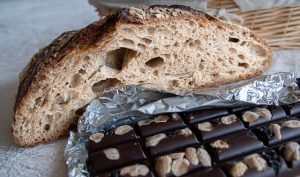
Last Updated on February 25, 2023 by Edible Alchemy Foods
When I first started baking, I was intrigued by the many varieties of breads I found online. But at that time, my baking skills were very limited and I didn’t know what they were all about. I had no idea whether to bake with whole wheat flour or white flour, nor did I understand why certain recipes called for different ingredients. And then came sourdough bread.
As someone who grew up in a small town where fresh-baked bread was almost always available, when I first saw the term “sourdough” on a recipe card, I immediately knew what it meant. It sounded like something I could make without much fuss. Plus, I had heard of sourdough before – it was the stuff that made my dad’s sandwiches so good. So I went looking online for some instructions.
To my delight, I found a video tutorial that showed me how easy it was to create my own sourdough starter! The next thing I knew, I was making bread every week. My friends and family loved it, and they begged me to share my secret.
But what exactly are these two types of breads? What makes one better than the other? I’ve been wondering this ever since I discovered them. And while I am still figuring things out, I thought I’d take a look at both types of breads and see if there’s any truth behind their labels.
Sourdough Vs. Peasant Bread
First off, let’s talk about what each of these terms means. According to Wikipedia, sourdough is “a mixture of yeasts and bacteria, including wild yeast, which ferments dough (leaven) over a long period of time.” In layman’s terms, sourdough means that the bread has been allowed to ferment for an extended amount of time. The longer the fermentation process lasts, the more sour the bread will be.
Peasant bread, on the other hand, is “bread baked using non-industrial methods. This includes no mechanical kneading, no preservatives, etc., but instead relies upon natural, spontaneous fermentation by yeasts, bacteria, and molds present in the flour.”
So what does this mean in practical terms? Let’s say you want to make a loaf of sourdough bread. First, you would need to get your starter going because the key to making great sourdough bread lies within it. To do this, you would mix equal parts of water and flour into a large bowl, and allow your starter to sit and grow overnight. Then you add your remaining ingredients, cover the bowl, and leave it alone until it has fermented for 24 hours.
You can either use a thermometer or stick your finger in the dough to determine when the dough should be ready to go into the oven. When the temperature reaches 110 degrees Fahrenheit, it’s time to pull your dough from the oven and shape it into a ball.
Once your dough is shaped into a ball, you have three options: place it back into your starter, place it directly into the oven, or place it in a covered container (such as a bread box) that allows air to circulate around it. After allowing it to cool, you can store it in the refrigerator for 3 days, or you can freeze it after it has rested for 12 hours. If you want to have it last longer, you can put the bread into the freezer. However, this also means that you’ll have to thaw it before eating it.
Why is peasant bread?
If you search for recipes for sourdough bread online, you’ll find that most of them require some type of starter. And if you look at the ingredients list for those recipes, you’ll often read something like “stir together 1 cup starter + 2 cups flour + 4 cups water.” That’s right—you need to start with a sourdough starter to make a good batch of sourdough bread.
That said, not everyone has access to a sourdough starter, and even if you do, you might not have enough room in your fridge for it. That’s why some people choose to make their own peasant bread instead.
In addition, some people prefer to bake their own bread because they think the quality is better than what you can buy at the supermarket. Others feel that they simply don’t have the time to devote to cooking and baking.
Why is it called peasant bread?
“Peasant” means country folk or rural folks. A lot of people assume that this term refers to the way peasants lived during medieval times, which is probably true. But the word “peasant” was used to describe anyone who did manual labor, regardless of race, gender, social status, nationality, or religion. Thus, the name became popularly applied to anyone who used basic tools and techniques to produce food, rather than relying on expensive machines.
Another theory is that the title comes from the fact that peasant bread contains no additives or preservatives and is therefore free of chemicals. That’s not necessarily true though. Many brands of pre-made, industrial breads contain stabilizers and emulsifiers.
Is peasant bread healthy for you?
Many people believe that peasant bread is healthier than its commercial counterpart. There is evidence to suggest that it may provide some health benefits. For example, some studies show that people who eat a diet rich in carbohydrates tend to suffer from constipation. Because peasant bread doesn’t contain refined grains, it contains higher amounts of fiber. Also, the high levels of protein in this type of bread helps us digest our meals.
On the other hand, it’s important to note that most of the research done with peasant bread has focused on its beneficial effects on health, whereas the research into sourdough bread hasn’t reached such conclusions yet. One study published in 2015 suggests that sourdough bread improves the absorption of iron and calcium in humans. Another study published in 2016 shows that sourdough bread increases antioxidant capacity and decreases oxidative stress in rats.
What is a sourdough starter?
A sourdough starter is a special type of yeast that can ferment dough. It consists primarily of wild yeast and lactic acid bacteria. Wild yeast is a form of fungus that lives in the environment and thrives on sugars. Lactic acid bacteria are a type of microorganism that live naturally inside your body. They convert simple sugar into lactic acid, which gives sourdough starters their characteristic tangy taste.
There are two ways to get your hands on a sourdough starter: you can purchase one from a local bakery or you can build your own. If you decide to make your own starter, it takes about 3 weeks to develop. During this time, you’ll need to mix flour, water, and salt at least once per day. Each time you mix the ingredients, cover the bowl and allow it to rest for about 10 minutes. Then remove the lid and stir. After 4 days, you will notice that the bread smells really nice.
At this point, it’s time to feed your starter. To do this, you’ll need to mix the flour, water, and salt again, but this time, mix it vigorously. Cover your bowl again, and allow it to rest for another 6 days. Finally, it’s time to harvest your starter. Remove the bowl from the refrigerator, mix the ingredients thoroughly, and pour your starter into a glass jar. Place the jar in a warm spot, preferably near your kitchen countertop. Once you see bubbles forming, your starter is ready to use.
Read:










